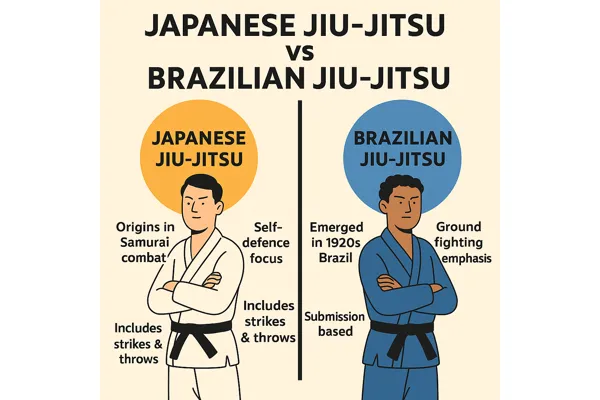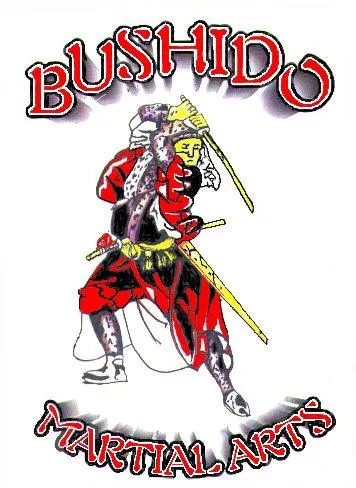
Japanese Jiu-Jitsu vs Brazilian Jiu-Jitsu: What’s the Difference?
At Bushido Martial Arts in Stockport, one of the most common questions we’re asked is:
“What’s the difference between Japanese Jiu-Jitsu and Brazilian Jiu-Jitsu?”
It’s a great question — and understanding the difference helps students choose the path that’s right for them. As a dojo specialising in traditional Japanese Jiu-Jitsu, we believe it’s important to offer a clear and honest comparison, based on history, techniques, and purpose.
🥋 The Origins: A Shared History
Japanese Jiu-Jitsu (also written as Jujutsu or Jujitsu) is the original form of the art — developed over 2,000 years ago and formalised in feudal Japan, particularly between the 8th and 16th centuries. It was created by and for the samurai class, who needed a way to defend themselves in close quarters if disarmed on the battlefield.
In 1532, Takenouchi Hisamori founded one of the first formal systems: Takenouchi-Ryu, combining unarmed techniques with small weapons and battlefield strategy. Over time, Japanese Jiu-Jitsu evolved into a complete system of self-defence, emphasising throws, locks, strikes, and control.
Brazilian Jiu-Jitsu, on the other hand, came much later — in the early 20th century. It was developed by the Gracie family in Brazil, most notably Helio Gracie, after being taught Judo (which evolved from Japanese Jiu-Jitsu) by Mitsuyo Maeda, a Japanese martial artist and Kodokan Judo expert.
In 1994, BJJ was formally recognised as its own sport by the Confederação Brasileira de Jiu-Jitsu (CBJJ), and later gained international recognition through organisations like the IBJJF (International Brazilian Jiu-Jitsu Federation).
⚔️ The Focus: Self-Defence vs Sport
Japanese Jiu-Jitsu (JJJ)
Rooted in real-world self-defence, not competition
Uses a combination of throws, strikes, joint locks, chokes, and weapon defences
Emphasises control, awareness, and finishing a situation quickly
Includes standing and ground-based techniques
Teaches the ability to defend against multiple attackers or armed threats
Brazilian Jiu-Jitsu (BJJ)
Specialises in ground fighting and submissions
Centres around positional control, sweeps, and submissions (chokes, armbars, etc.)
Designed largely for 1-on-1 grappling, not multiple attackers
Practised widely as a competitive sport
Highly effective in MMA (Mixed Martial Arts) settings
🧠 Philosophy and Teaching Style
At Bushido Martial Arts, our focus is on practical self-defence, not just winning points or medals. Japanese Jiu-Jitsu teaches students to:
Stay calm under pressure
Neutralise threats with minimal force
Use leverage and redirection, not brute strength
Defend against strikes, weapons, and multiple attackers
BJJ schools tend to place more emphasis on sparring (rolling), physical conditioning, and sport-based progression.
🏅 Grading and Recognition
Japanese Jiu-Jitsu:
Follows a kyu/dan ranking system (as used in many traditional Japanese arts)
Gradings are based on technical demonstration, self-control, and understanding
At Bushido, students must meet minimum training hours, demonstrate syllabus content, and show confidence and control in a live grading setting
Brazilian Jiu-Jitsu:
Also uses belt colours, but with longer gaps between promotions
Heavily based on sparring performance
Progression is often judged in class, rather than in a formal grading setting
🏆 So Which One Should You Choose?
There’s no “better” style — only what’s best for you.
If you’re looking for:
A well-rounded martial art that includes both standing and ground techniques
A focus on self-defence, discipline, and real-world application
Training rooted in centuries of tradition, but relevant for today’s world
Best Option for You?
Choose Japanese Jiu-Jitsu if you want a fuller self-defence system grounded in tradition, striking, throws, and control
Consider Brazilian Jiu-Jitsu if your interest is in grappling sport, submission technique, and live sparring proficiency
Top Brazilian Jiu-Jitsu Dojo in Greater Manchester
If you're interested in training in Brazilian Jiu-Jitsu, the top-reviewed school in Greater Manchester based on Google and Facebook reviews is Stealth BJJ HQ Manchester. Here’s why:
Highly experienced coaching team, including 4th-degree black belt instructors and a welcoming atmosphere
Large, clean facilities and a structured syllabus for beginners through advanced students
Numerous reviews highlight their friendly community, effective teaching, and inclusive environment
Another local option is Valour JiuJitsu Manchester (Eccles), praised for quality instruction, safety, and community support—especially for families and beginner-friendly programmes.
Final Thoughts
Both Japanese Jiu-Jitsu and Brazilian Jiu-Jitsu offer powerful training, but they serve different purposes:
Japanese Jiu-Jitsu (as taught at Bushido): broad, practical, tradition-based, ideal for real-life self-defence
Brazilian Jiu-Jitsu: excellent for ground fighting, submissions, and competitive grappling
If you're still unsure, many schools—including both here at Bushido and at Stealth BJJ—offer trial classes so you can experience each style firsthand before deciding.

